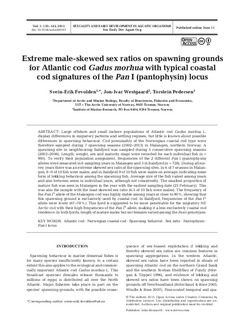| dc.description.abstract | Large offshore and small inshore populations of Atlantic cod Gadus morhua L. display differences in migratory patterns and settling regimes, but little is known about possible differences in spawning behaviour. Cod presumably of the Norwegian coastal cod type were therefore sampled during 7 spawning seasons (2002-2013) in Malangen, northern Norway. A spawning site in neighbouring Balsfjord was sampled during 5 consecutive spawning seasons (2002-2006). Length, weight, sex and maturity stage were recorded for each individual fish (n = 995). To verify their population assignment, frequencies of the 2 different Pan I (pantophysin) alleles were measured in 6 sampling years in Malangen and 3 in Balsfjord (n = 728). During all survey years there was an extreme skewed sex ratio at the spawning sites. In 6 of 7 seasons in Malangen, 8–9 of 10 fish were males, and in Balsfjord 9 of 10 fish were males on average, indicating some form of lekking behaviour among the spawning fish. Average size of the fish varied among years and also between sexes in individual years, although not consistently. The smallest proportion of mature fish was seen in Malangen in the year with the earliest sampling date (23 February). This was also the sample with the least skewed sex ratio (6.5 of 10 fish were males). The frequency of the Pan IA allele of the Malangen cod was highly stable among years at close to 90%, showing that this spawning ground is exclusively used by coastal cod. In Balsfjord, frequencies of the Pan IA allele were lower (67-78%). This fjord is suggested to be more penetrable for the migratory NE Arctic cod with their high frequencies of the Pan IB allele, making it a less exclusively coastal cod residence. In both fjords, length of mature males but not females varied among the Pan I genotypes. | nb_NO |

